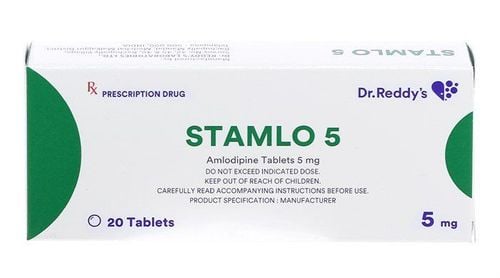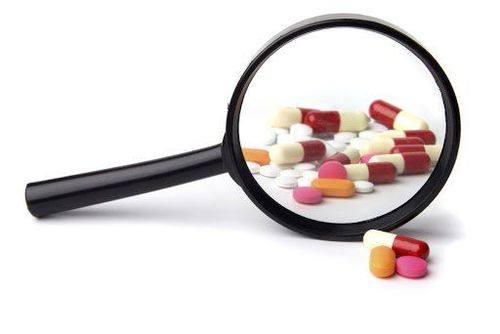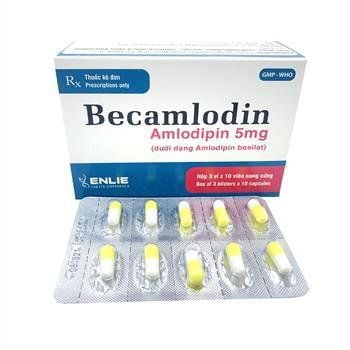This is an automatically translated article.
Stamlo 5mg contains the active ingredient amlodipine, a dihydropyridine calcium channel blocker. Many patients still wonder about the use of Stamlo 5mg. The article will provide readers with some general information about this drug.
1. What are the effects of Stamlo 5mg?
Amlodipine is a dihydropyridine derivative of the calcium channel blocker class. It has the effect of blocking L-type calcium channels in arterial and cardiac smooth muscle, so it reduces intracellular Ca, thereby preventing vascular smooth muscle contraction. Amlodipine exerts its antihypertensive effect by relaxing peripheral arterial smooth muscle and has less effect on myocardial calcium channels. Therefore, the drug does not affect atrioventricular conduction and myocardial contractility. Amlodipine may also decrease renal vascular resistance, thereby increasing renal blood flow and improving renal function. In patients with exercise-induced angina, amlodipine reduces peripheral resistance, reducing myocardial work, thereby reducing myocardial oxygen demand. In addition, amlodipine helps to dilate coronary vessels both in ischemic and normal areas, thereby increasing oxygenation in patients with spasmodic angina (Prinzmetal's angina).
Amlodipine is well absorbed from the oral route and peak plasma concentrations are achieved approximately 6 to 12 hours after dosing. The half-life of amlodipine ranges from 35 to 50 hours and is consistent with once-daily dosing. Stable plasma concentrations are achieved after 7 to 8 days of continuous dosing. Amlodipine is extensively metabolised in the liver to inactive metabolites and excreted in the urine.
2. What are the indications and contraindications of Stamlo 5mg?
2.1 Indications Stamlo 5mg can be prescribed to treat the following cases:
Hypertension; Chronic stable angina Vasoconstrictor angina (Prinzmetal's angina). 2.2. Contraindications Hypersensitivity to amlodipine or any component of the drug

Stamlo 5mg là thuốc thuộc nhóm chẹn kênh canxi
3. What is the dose of Stamlo 5?
For the treatment of hypertension and angina, the usual starting dose is 5 mg once daily, which may be increased to 10 mg once daily depending on individual patient response. In geriatric patients: Tolerability is similar in the elderly and younger patients when similar doses of amlodipine are used. Caution should be exercised when increasing the dose in the elderly Children and adolescents: Children and adolescents 6 to 17 years of age with hypertension may receive an initial dose of 2.5 mg once daily, followed by increasing up to 5 mg/day if desired effect has not been achieved after four weeks. Doses greater than 5 mg/day have not been studied in pediatric patients. There are not many data in children under 6 years of age. Patients should note, the above dose is for reference only. The specific dose will depend on the condition and severity of the disease. You need to consult your doctor or medical staff to get the right dose.
4. What to do in case of overdose?
An overdose of stamlo 5mg can cause peripheral vasodilation, accompanied by tachycardia. There have been reports of a sharp drop in blood pressure, even shock and death. Absorption of amlodipine was significantly reduced when activated charcoal was administered immediately or within 2 hours of oral administration in healthy volunteers. In some cases gastric lavage may be necessary. Patients with severe hypotension due to overdosage of amlodipine should have cardiovascular supportive measures including regular monitoring of cardiovascular and respiratory functions, elevation of limbs, and attention to week volume. urine output. In some cases, your doctor may prescribe vasopressors to restore blood pressure. Because amlodipine is highly bound to plasma proteins, dialysis is not effective.
5. What are the unwanted effects of the drug?
> 10%: Peripheral edema
1-10%:
Cardiovascular: Facial flushing, palpitations Dermatology: Itching, skin rash Gastrointestinal: Abdominal pain, nausea Nervous system: Dizziness, somnolence , fatigue, sexual dysfunction in men Neuromuscular and skeletal: Asthenia, cramps Respiratory: Shortness of breath <1%:
Cardiovascular: Peripheral ischemia, tachycardia, syncope, inflammation Vascular Dermatology: erythema multiforme Endocrine and metabolic: Hot flashes, hyperglycemia, weight gain, weight loss Gastrointestinal: Anorexia, constipation, dysphagia, flatulence, gingival hyperplasia, pancreatitis, vomiting , Genitourinary system: Difficulty urinating, nocturia, frequent urination. Hematology & Oncology: Leukopenia, purpura, thrombocytopenia Hypersensitivity: Angioedema, hypersensitivity reactions Nervous system: Abnormal dreams, anxiety, depression, sexual dysfunction in female, insomnia, irritability, pain, paresthesia, peripheral neuropathy Neuromuscular and skeletal: Arthralgia, back pain, myalgia, osteoarthritis, tremor Ophthalmic: Conjunctivitis, double vision, eye pain

Stamlo 5mg có thể khiến người bệnh gặp tình trạng đau khớp
6. What is the note when using Stamlo 5mg?
Hypotension: Symptomatic hypotension may occur. Acute hypotension at the beginning of treatment is unlikely as the effects of the drug begin slowly. Aortic stenosis: Amlodipine should be used with extreme caution in patients with severe aortic stenosis because it may reduce coronary perfusion leading to ischemia. Hepatic impairment: Caution is advised when administering Stamlo 5mg to patients with hepatic impairment. Use in Heart Failure: In a study using amlodipine in patients with New York Heart Association Class III and IV heart failure, amlodipine was reported to be associated with an increased incidence of heart failure. rate of pulmonary edema. However, there was no significant difference in the proportion of patients with severe heart failure in the amlodipine group compared with the placebo group. Elderly: May be started with a low dose and with caution when increasing the dose in the elderly. Drug interactions: Some drugs when used concurrently with Stamlo 5mg can cause many adverse reactions. To avoid drug interactions, you must inform your doctor or pharmacist of all the medicines you are taking for appropriate advice and adjustment. Ability to drive and use machines: The drug may affect the ability to use machines due to the risk of some undesirable effects such as headache, dizziness, fatigue, drowsiness. Therefore, patients taking the drug should be careful when driving or operating machinery. Pregnancy: Amlodipine crosses the placenta. In general, calcium channel blockers can be used to treat hypertension in pregnant women, however, agents other than amlodipine are more commonly used. Women with pre-existing hypertension may continue to take the drug during pregnancy unless contraindicated. Lactation: Amlodipine may be excreted in human milk. The milk/plasma concentration ratio of amlodipine in 31 lactating women with gestational hypertension was 0.85 following administration of amlodipine at an initial dose of 5 mg once daily and adjusted as needed (dose Average daily dose and daily dose by body weight were 6 mg and 98.7 mcg/kg, respectively). The estimated daily dose of amlodipine received by an infant through breast milk is approximately 4.17 mcg/kg. In summary, Stamlo 5mg is a calcium channel blocker antihypertensive drug. The drug may cause some unwanted effects such as ankle swelling, facial flushing, palpitations, etc. When experiencing side effects of the drug, patients need to contact a doctor to be adjusted. dose or change to another suitable drug.
Please dial HOTLINE for more information or register for an appointment HERE. Download MyVinmec app to make appointments faster and to manage your bookings easily.













